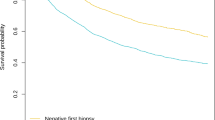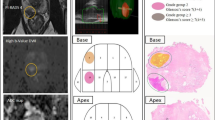Abstract
Background
In current precision prostate cancer (PCa) surgery era the identification of the best patients candidate for prostate biopsy still remains an open issue. The aim of this study was to evaluate if the prostate target biopsy (TB) outcomes could be predicted by using artificial intelligence approach based on a set of clinical pre-biopsy.
Methods
Pre-biopsy characteristics in terms of PSA, PSA density, digital rectal examination (DRE), previous prostate biopsies, number of suspicious lesions at mp-MRI, lesion volume, lesion location, and Pi-Rads score were extracted from our prospectively maintained TB database from March 2014 to December 2019. Our approach is based on Fuzzy logic and associative rules mining, with the aim to predict TB outcomes.
Results
A total of 1448 patients were included. Using the Frequent-Pattern growth algorithm we extracted 875 rules and used to build the fuzzy classifier. 963 subjects were classified whereas for the remaining 484 subjects were not classified since no rules matched with their input variables. Analyzing the classified subjects we obtained a specificity of 59.2% and sensitivity of 90.8% with a negative and the positive predictive values of 81.3% and 76.6%, respectively. In particular, focusing on ISUP ≥ 3 PCa, our model is able to correctly predict the biopsy outcomes in 98.1% of the cases.
Conclusions
In this study we demonstrated that the possibility to look at several pre-biopsy variables simultaneously with artificial intelligence algorithms can improve the prediction of TB outcomes, outclassing the performance of PSA, its derivates and MRI alone.
This is a preview of subscription content, access via your institution
Access options
Subscribe to this journal
Receive 4 print issues and online access
$259.00 per year
only $64.75 per issue
Buy this article
- Purchase on SpringerLink
- Instant access to full article PDF
Prices may be subject to local taxes which are calculated during checkout

Similar content being viewed by others
References
Checcucci E, Amparore D, De Luca S, Autorino R, Fiori C, Porpiglia F. Precision prostate cancer surgery: an overview of new technologies and techniques. Minerva Urol Nefrol. 2019;71:487–501.
Checcucci E, Autorino R, Cacciamani GE, Amparore D, De Cillis S, Piana A, et al. Artificial intelligence and neural networks in Urology: current clinical applications. Minerva Urol Nefrol. 2020;72:49–57.
Giannini V, Rosati S, Regge D, Balestra G. Specificity improvement of a CAD system for multiparametric MR prostate cancer using texture features and artificial neural networks. Health Technol. 2017;7:71–80.
Rosati S, Balestra G, Giannini V, Mazzetti S, Russo F, Regge D. ChiMerge discretization method: Impact on a computer aided diagnosis system for prostate cancer in MRI. In: Turin 2015 IEEE International Symposium on Medical Measurements and Applications (MeMeA) Proceedings. IEEE; 2015. p. 297–302.
Bhandari M, Reddiboina M. Building artificial intelligence-based personalized predictive models. BJU Int. 2019;124:189–91.
Hung AJ. Can machine-learning algorithms replace conventional statistics? BJU Int. 2019;123:1.
Checcucci E, De Cillis S, Granato S, Chang P, Afyouni AS, Okhunov Z; Uro-technology and SoMe Working Group of the Young Academic Urologists Working Party of the European Association of Urology. Applications of neural networks in urology: a systematic review. Curr Opin Urol. 2020;30:788–807. https://doi.org/10.1097/MOU.0000000000000814.
Rosati S, Agostini V, Balestra G, Knaflitz M. Basographic gait impairment score: a fuzzy classifier based on foot-floor contact parameters. In: 2014 IEEE International Symposium on Medical Measurements and Applications (MeMeA). 2014. p. 1–5.
Barentsz JO, Richenberg J, Clements R, Choyke P, Verma S, Villeirs G, et al. ESUR prostate MR guidelines 2012. Eur Radiol. 2012;22:746–57. https://doi.org/10.1007/s00330-011-2377-y.
Barentsz JO, Weinreb JC, Verma S, Thoeny HC, Tempany CM, Shtern F, et al. Synopsis of the PI-RADS v2 guidelines for multiparametric prostate magnetic resonance imaging and recommendations for use. Eur Urol. 2016;69:41–9. https://doi.org/10.1016/j.eururo.2015.08.038.
Han J, Pei J, Yin Y, Mao R. Mining frequent patterns without candidate generation: a frequent-pattern tree approach. Data Min Knowl Discov. 2004;8:53–87.
Checcucci E, De Cillis S, Piramide F, Amparore D, Kasivisvanathan V, Giganti F, et al. The role of additional standard biopsy in the MRI-targeted biopsy era. Minerva Urol Nefrol. 2020;72:637–9.
Mazzone E, Stabile A, Pellegrino F, Basile G, Cignoli D, Cirulli GO, et al. Positive predictive value of prostate imaging reporting and data system version 2 for the detection of clinically significant prostate cancer: a systematic review and meta-analysis. Eur Urol Oncol. 2020;S2588-9311:30212-1. https://doi.org/10.1016/j.euo.2020.12.004.
Mottet N, van den Bergh RCN, Briers E, Van den Broeck T, Cumberbatch MG, De Santis M, et al EAU-EANM-ESTRO-ESUR-SIOG Guidelines on Prostate Cancer-2020 Update. Part 1: Screening, Diagnosis, and Local Treatment with Curative Intent. Eur Urol. 2021;79:243-62. https://doi.org/10.1016/j.eururo.2020.09.042.
Mortezavi A, Palsdottir T, Eklund M, Chellappa V, Murugan SK, Saba K, et al. Head-to-head Comparison of Conventional, and Image- and Biomarker-based Prostate Cancer Risk Calculators. Eur Urol Focus. 2020;S2405-4569:30113-9. https://doi.org/10.1016/j.euf.2020.05.002. Epub ahead of print.
Roffman DA, Hart GR, Leapman MS, Yu JB, Guo FL, Ali I, et al. Development and Validation of a Multiparameterized Artificial Neural Network for Prostate Cancer Risk Prediction and Stratification. JCO Clin Cancer Inform. 2018;2:1–10. https://doi.org/10.1200/CCI.17.00119.
Amparore D, Campi R, Checcucci E, Sessa F, Pecoraro A, Minervini A, et al. Forecasting the Future of Urology Practice: A Comprehensive Review of the Recommendations by International and European Associations on Priority Procedures During the COVID-19 Pandemic. Eur Urol Focus. 2020;6:1032–48. https://doi.org/10.1016/j.euf.2020.05.007.
Wallis CJD, Novara G, Marandino L, A Bex, AM Kamat, RJ Karnes, et al. Risks from deferring treatment for genitourinary cancers: a collaborative review to aid triage and management during the COVID-19 pandemic. Eur Urol 2020;78:29–42. https://doi.org/10.1016/j.eururo.2020.04.063.
Author information
Authors and Affiliations
Contributions
EC: study design, paper writing, data collection, and data interpretation. SR: data analysis, paper writing. SDC: data collection. MV: data analysis. NG: data analysis. AP: data collection. SG: data collection. DA: study design, supervision. SDL: study design, supervision. CF: study design, supervision. GB: study design, supervision, and data analysis. FP: study design, supervision.
Corresponding author
Ethics declarations
Competing interests
The authors declare no competing interests.
Ethics approval
The study was conducted in accordance with good clinical practice guidelines, and informed consent was obtained from the patients. According to Italian law (Agenzia Italiana del Farmaco Guidelines for Observational Studies, March 20, 2008), no formal institutional review board or ethics committee approval was required.
Additional information
Publisher’s note Springer Nature remains neutral with regard to jurisdictional claims in published maps and institutional affiliations.
Rights and permissions
About this article
Cite this article
Checcucci, E., Rosati, S., De Cillis, S. et al. Artificial intelligence for target prostate biopsy outcomes prediction the potential application of fuzzy logic. Prostate Cancer Prostatic Dis 25, 359–362 (2022). https://doi.org/10.1038/s41391-021-00441-1
Received:
Revised:
Accepted:
Published:
Issue date:
DOI: https://doi.org/10.1038/s41391-021-00441-1
This article is cited by
-
Accuracy, readability, and understandability of large language models for prostate cancer information to the public
Prostate Cancer and Prostatic Diseases (2025)
-
Quality of information and appropriateness of Open AI outputs for prostate cancer
Prostate Cancer and Prostatic Diseases (2025)
-
Follow-up on patients with initial negative mpMRI target and systematic biopsy for PI-RADS ≥ 3 lesions – an EAU-YAU study enhancing prostate cancer detection
Prostate Cancer and Prostatic Diseases (2025)
-
Quality of information and appropriateness of ChatGPT outputs for urology patients
Prostate Cancer and Prostatic Diseases (2024)
-
Developers-Doctor-patients: the artificial intelligence’s trifecta
Prostate Cancer and Prostatic Diseases (2024)



